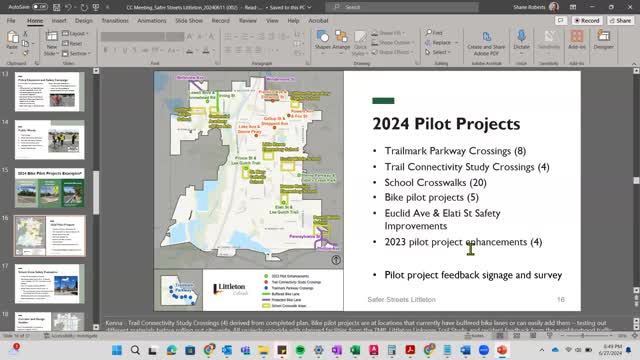City launches ambitious bike lane initiative to enhance safety
June 28, 2024 | Littleton City, Arapahoe County, Colorado

This article was created by AI summarizing key points discussed. AI makes mistakes, so for full details and context, please refer to the video of the full meeting. Please report any errors so we can fix them. Report an error »

In a recent government meeting, officials discussed the implementation of various pilot projects aimed at enhancing pedestrian and cyclist safety across the city. The initiatives, part of a broader \"Safer Streets\" program, include the installation of new crosswalks, protected bike lanes, and upgraded bike facilities, particularly around schools and high-traffic areas.
The projects are designed to draw attention to pedestrian zones and improve safety for children walking to school. Officials emphasized that while some of these initiatives are new, many are based on existing plans that have been accelerated due to recent funding opportunities. The goal is to implement these changes quickly, with most installations expected to be completed by summer, although some may extend into the fall.
Key discussions highlighted the importance of connectivity in the bike lane network. Officials acknowledged concerns raised about the lack of connections between various bike lanes, which could hinder their effectiveness. They are actively seeking grant funding to improve internal roadways and create a more cohesive biking infrastructure.
Innovative materials are being tested in these projects, including new types of protective barriers designed to enhance safety for cyclists. These materials are intended to withstand impacts from vehicles while redirecting them back into their lanes, thereby reducing the risk of accidents.
Feedback from community members is being actively sought as part of the quick-build approach, allowing for adjustments based on real-world usage and experiences. Officials are committed to ensuring that the new installations do not obstruct existing infrastructure, such as drainage systems, and are open to making changes based on public input.
Overall, the meeting underscored a proactive approach to urban planning, focusing on immediate improvements to safety and accessibility for all road users, while also laying the groundwork for future enhancements to the city's transportation network.
The projects are designed to draw attention to pedestrian zones and improve safety for children walking to school. Officials emphasized that while some of these initiatives are new, many are based on existing plans that have been accelerated due to recent funding opportunities. The goal is to implement these changes quickly, with most installations expected to be completed by summer, although some may extend into the fall.
Key discussions highlighted the importance of connectivity in the bike lane network. Officials acknowledged concerns raised about the lack of connections between various bike lanes, which could hinder their effectiveness. They are actively seeking grant funding to improve internal roadways and create a more cohesive biking infrastructure.
Innovative materials are being tested in these projects, including new types of protective barriers designed to enhance safety for cyclists. These materials are intended to withstand impacts from vehicles while redirecting them back into their lanes, thereby reducing the risk of accidents.
Feedback from community members is being actively sought as part of the quick-build approach, allowing for adjustments based on real-world usage and experiences. Officials are committed to ensuring that the new installations do not obstruct existing infrastructure, such as drainage systems, and are open to making changes based on public input.
Overall, the meeting underscored a proactive approach to urban planning, focusing on immediate improvements to safety and accessibility for all road users, while also laying the groundwork for future enhancements to the city's transportation network.
View full meeting
This article is based on a recent meeting—watch the full video and explore the complete transcript for deeper insights into the discussion.
View full meeting
